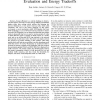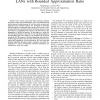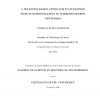ICCCN
2008
IEEE
14 years 9 months ago
2008
IEEE
Abstract—Energy efficiency is a central challenge in batteryoperated sensor networks. Current energy-efficient mechanisms employ either duty cycling, which reduces idle listeni...
ICCCN
2008
IEEE
14 years 9 months ago
2008
IEEE
— The current access point (AP) association schemes in wireless LANs, such as IEEE 802.11, cause an unbalanced load which reduces the performance of both the entire network and i...
ICCCN
2008
IEEE
14 years 9 months ago
2008
IEEE
—We address the problem of modeling and adapting JPEG to the energy requirements of Visual Sensor Networks (VSN). For JPEG modeling purposes, we develop a simplified high-level ...
ICCCN
2008
IEEE
14 years 9 months ago
2008
IEEE
—Flow aggregation has been proposed as a technique to improve the scalability of QoS scheduling in the core of the Internet, by reducing the amount of per-flow state necessary a...
ICCCN
2008
IEEE
14 years 9 months ago
2008
IEEE
—Effective defenses against DDoS attacks that deplete resources at the network and transport layers have been deployed commercially. Therefore, DDoS attacks increasingly use norm...
ICCCN
2008
IEEE
14 years 9 months ago
2008
IEEE
— The Recursive Network Architecture (RNA) explores the relationship of layering to protocol and network architecture. RNA examines the implications of using a single, tunable pr...
ICCCN
2008
IEEE
14 years 9 months ago
2008
IEEE
—We investigate the p-percent coverage problem in this paper and propose two algorithms to prolong network lifetime based on the fact that for some applications full coverage is ...
ICCCN
2008
IEEE
14 years 9 months ago
2008
IEEE
—Broadcast presents a special challenge for Wireless Sensor Networks (WSNs). In some situation such as time synchronization or building routing path, broadcasting messages must b...
ICCCN
2008
IEEE
14 years 9 months ago
2008
IEEE
ICCCN
2008
IEEE
14 years 9 months ago
2008
IEEE
: Recent studies on inter-domain DWDM networks used on topology abstraction for state summarization, i.e., transforming a physical topology to a virtual mesh, tree, or star network...





